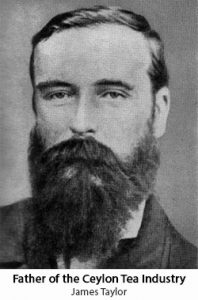Was the founder member and the father figure of the present Raxawa legacy (1903 – 1989). Caringly and lovingly nurtured by Mr. Salih, who was also very well known as a Planter and Tea manufacturer, started Raxawa’s enterprising and thriving journey of 90 years. Mr.Salih started planting Tea, coffee and spices in 1925 in Kandy and Matale districts. He owned more than 1000 acres and the beginning of his first exciting Tea production and his dedicated Tea factory started in 1934.
About Us
LEGACY OF 90 YEARS
Late Mr.Omer Salih (Proprietor).
Mr.Najumdeen Salih (Present Proprietor).
Mr.Najumdeen who follow the footsteps of his father started planting Tea in 1960. An enterprising planter and a Tea manufacturer with a mind for every tiny detail, high-quality production, superior high-grade Tea, continue his father’s business as at present. As a result of his hard work, dedication and the commitment to carry forward his late father’s legacy became the present owner of this fully automated and one of the best Tea producing Factories in Srilanka.
Mr. Nafees Najumdeen (Director).
Mr.Nafees Najumdeen who is a successful planter began Tea manufacturing since 1994, is attached to Prime Tea Ceylon (Pvt) Ltd / Raxawa Tea factory (Pvt) Ltd. Well equipped with vast experience in best quality Tea manufacturing since then, has years of thorough knowledge in Tea planting, manufacturing, Tea tasting, grading and marketing is a true and a valuable asset who plays a big role towards the success of the legacy.
Mr.Naleem Najumdeen (Director).
Well experienced and a professional Tea taster for more than 20 years, Mr.Naleem has worked as a Tea broker and auctioneer as well. Overseeing and ensuring smooth production and the superior quality of all the Tea productions at Prime Tea Ceylon (Pvt) Ltd /Raxawa Tea Factory (Pvt) Ltd. His exceptionally and rare good knowledge in all types of Tea, manufacturing, grading, blending and marketing, have made the 90 years of the thriving Raxawa legacy journey, an exclusively unbeatable and one of the top brands at present, which has won the hearts and minds of a large number of consumers in the local and the international Tea market
HISTORY OF CEYLON TEA
The Sri Lankan history revealed that in the year 1834, The British started cultivating Tea in their colonies in India and in Sri Lanka, which was well known by the rest of the world as ‘The British Ceylon’. The name Ceylon was given to this paradise Island nation Sri Lanka by The British government before Sri Lanka won its independence in the year 1948 and is also very famously known in the world as the Pearl or the Teardrop of the Indian ocean. Since then, this world-acclaimed superior quality Tea produced in Sri Lanka became reputed in the International Tea market as Pure Ceylon Tea. The first commercial planting of Tea in Ceylon was undertaken by James Taylor only in 1867 on a 19-acre land in Loolecondera estate in the hill capital, Kandy, where eventually the land was turned into a Tea plantation later. James Taylor’s name entered into the history of Ceylon as the first pioneer and the founder of the Tea industry in Sri Lanka.

Thereafter, the first public Tea auction took place in Ceylon on the 30th of July in 1883 at the office of Messrs. Sommerville and Company Colombo. Then in the year 1873, the first consignment of Tea was exported from Sri Lanka and the production of pure quality Ceylon Tea topped the one million kilo mark by the year 1884. Since then the production of pure Ceylon Tea had steadily increased to the extent, that it has become the major export commodity, as well as Sri Lanka stands on top in the International Tea export market, for its unique taste and aroma. The Tea plant grows from almost sea level to a higher elevation of 2,000 to 3,000 meters above the sea level in acid red yellow Podzolic to reddish-brown lateritic soils. The Tea-growing areas in Sri Lanka experience an annual rainfall of 1,500 to 5,300 millimetres (mm) or more, with a minimum temperature of 14 deg.C and a maximum temperature of 28 deg.C respectively. Today the habit of Tea-drinking has spread all over the world. It is second only to water as the most favourite beverage in the world. Most people drink Tea as a social drink because of its pleasant and stimulating character. Recent biomedical research confirms, that this century-old traditional beverage has the power to prevent illnesses and prolong life.
Thereafter, the first public Tea auction took place in Ceylon on the 30th of July in 1883 at the office of Messrs. Sommerville and Company Colombo. Then in the year 1873, the first consignment of Tea was exported from Sri Lanka and the production of pure quality Ceylon Tea topped the one million kilo mark by the year 1884. Since then the production of pure Ceylon Tea had steadily increased to the extent, that it has become the major export commodity, as well as Sri Lanka stands on top in the International Tea export market, for its unique taste and aroma. The Tea plant grows from almost sea level to a higher elevation of 2,000 to 3,000 meters above the sea level in acid red yellow Podzolic to reddish-brown lateritic soils. The Tea-growing areas in Sri Lanka experience an annual rainfall of 1,500 to 5,300 millimetres (mm) or more, with a minimum temperature of 14 deg.C and a maximum temperature of 28 deg.C respectively. Today the habit of Tea-drinking has spread all over the world. It is second only to water as the most favourite beverage in the world. Most people drink Tea as a social drink because of its pleasant and stimulating character. Recent biomedical research confirms, that this century-old traditional beverage has the power to prevent illnesses and prolong life.

